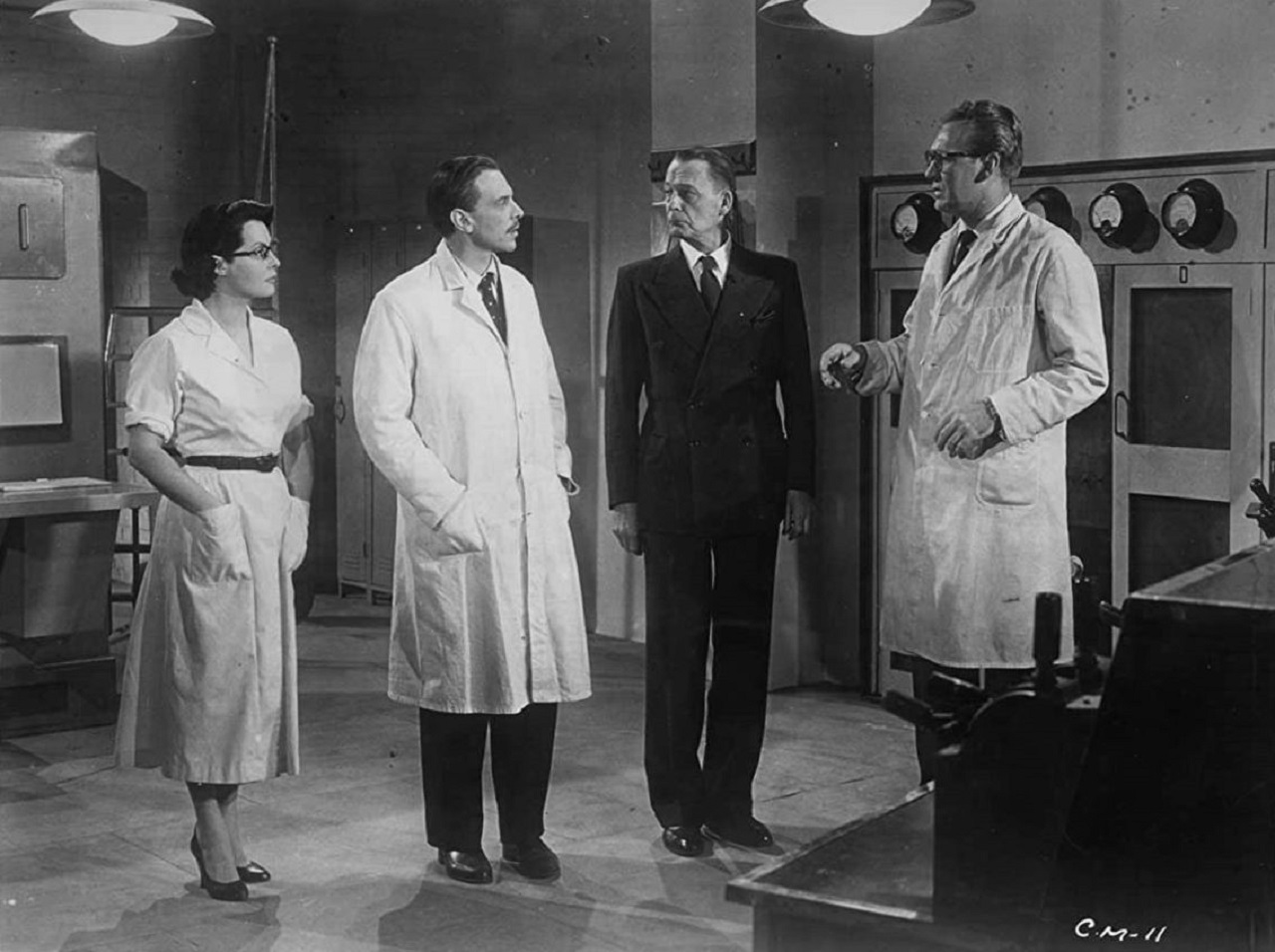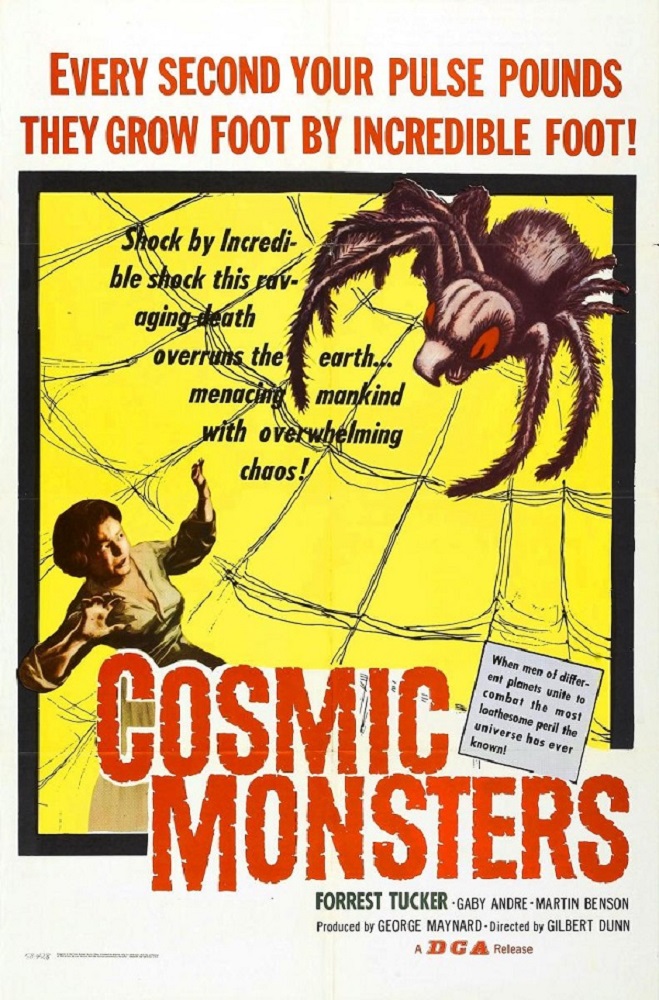aka Cosmic Monsters
Crew
Director – Gilbert Gunn, Screenplay – Paul Ryder, Based on the Novel by Rene Ray, Producer – George Maynard, Photography (b&w) – Joe Ambor, Music – Robert Sharples, Special Effects – Anglo-Scottish Pictures Ltd, Makeup – Charles Nash, Art Direction – Bernard Sarron. Production Company – Artistes Alliance (W.N.W.) Ltd.
Cast
Forrest Tucker (Gil Graham), Gaby André (Michele Dupont), Martin Benson (Mr Smith), Alec Mango (Dr Laird), Geoffrey Chater (Gerard Wilson), Wyndham Goldie (Brigadier Cartwright), Hugh Latimer (Jimmy Murray), Patricia Sinclair (Helen Forsyth), Susan Redway (Jane Hale), Richard Warner (Inspector Burns), Hilda Fennemore (Mrs Hale), Dandy Nichols (Mrs Tucker)
Plot
American Gil Graham works as assistant to Dr Laird who is conducting experiments in creating massive magnetic fields from a laboratory in his home in the sleepy English town of Briarley Bay. When the other assistant is injured in an explosion, they receive a replacement in the pretty French girl Michele Dupont who Gil becomes attracted to. Laird has discovered a mean of using the magnetic fields to cause metals to turn supple and even be reduced to powder and the military are interested in potential application of this. Laird becomes obsessed with pushing the experiments even further. At the same time, strange things are being reported – UFOs in the skies and a facially disfigured tramp in the woods attacking people. Gil is then contacted by the mysterious Mr Smith who insists that the experiments be stopped because they have weakened the Earth’s ionosphere and this is allowing natural cosmic radiation through. As they now become aware, the radiation has caused local insect-life to become giant-sized.
The British science-fiction film of the 1950s was a less prolific but certainly no less fascinating a beast than its American counterparts. There were some essential differences between the two. British science-fiction films as a whole were more parochial, more set around the notion of a cosy country village, than US films, and lack any allegorical fears for the Communist menace. The groundbreaker in the field had been The Quatermass Xperiment (1955), which had first appeared as a highly successful tv series and was then made into a film. TV serial to the big screen was a similar path taken by other British science-fiction works of the era with the likes of Nineteen Eighty-Four (1956), The Abominable Snowman (1957) and The Trollenberg Terror/The Crawling Eye (1958). Likewise, The Strange World of Planet X/Cosmic Monsters had first appeared as The Strange World of Planet X (1956), a serial in six parts of thirty minutes each from the UK’s ATV channel, all episodes of which are now believed to be lost.
Another peculiarity The Quatermass Xperiment started was to take the X certificate the British censorship board slapped on the film as a badge of pride as highlighted by the pointed misspelling of the world ‘experiment’ in the title. This was copied by other works such as X the Unknown (1956) and The Strange World of Planet X here. There was also the habit, as was started by The Quatermass Xperiment and copied by many of the British science-fiction films of the era, to import an American lead to carry the film across the Atlantic – in this case, we have Forrest Tucker, a minor name in B Westerns of the 1940s, who managed to make a career out of appearing in British science-fiction films of this period, including also The Abominable Snowman and The Trollenberg Terror.
The Strange World of Planet X, known as Cosmic Monsters in the US, has a reputation as a bad movie, although aside from failings in the special effects department that kill it in the latter half (see below), it has a routine competence for the most part. It is directed by Gilbert Gunn who made a handful of forgotten British quota quickies and whose only other genre outing was the Loch Ness monster comedy What a Whopper (1961). Gunn builds up a passable mystery about the experiments, the mysterious stranger (a young Martin Benson) and, an aspect clearly borrowed from The Quatermass Xperiment, the tramp with a disfigured face wandering the woods attacking people.

The film unfortunately falls down in the second half. Firstly, the title leads you to expect one thing – an alien invasion or interplanetary exploration film when in fact what we end up with is more akin to one of the giant insect films that came out after the success of Them! (1954) – the only occasion that British cinema ventured into this particular theme.
The title The Strange World of Planet X is eventually sort of justified towards the end as being a fanciful metaphor for Earth but the threat is disappointingly terrestrial the entire way. (The title makes far more sense in the original tv serial, which differs widely from the film, where the story in fact concerned scientists opening up a doorway that allowed them to explore another dimension). There is a mysterious alien stranger who has clearly been modelled on Michael Rennie’s Klaatu from The Day the Earth Stood Still (1951) who is benevolent in nature and eventually departs in a UFO after not doing very much.
It is however the utterly inadequate special effects that do the film in. To represent the giant monsters, the production has opted for the good old B movie standard of optically enlarged insects. What we end up with looks precisely like a series of badly inserted praying mantises pretending to attack people. The UFO that appears at the end also had a clearly visible wire holding it up. One of the more amusing aspects in seeing the film today is its quaintly dated sexist attitudes – like when the idea of the scientists getting a female lab assistant is greeted with lines like “A woman? This is preposterous. This is highly skilled work.”


